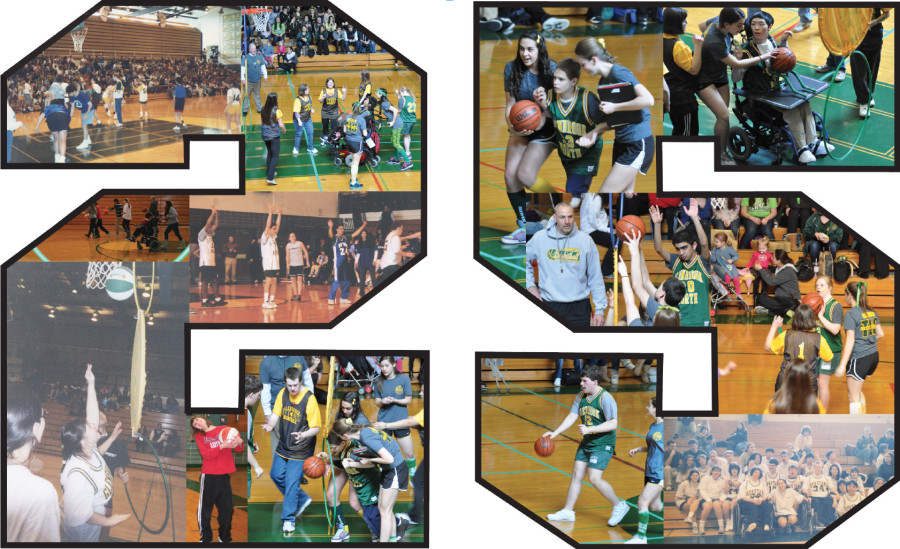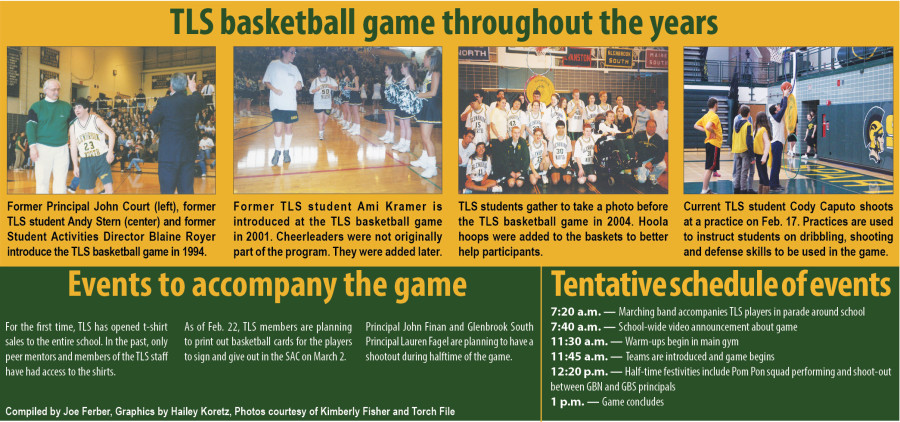Annual TLS basketball game celebrates 25th anniversary

Kimberly Fisher, co-founder of the Teaching for Life Skills (TLS) basketball game, will always remember TLS student Kenny Dempsey.
According to Fisher, Dempsey was good at scoring two-pointers but insisted on shooting three-point shots. During a game, Dempsey changed his strategy after receiving advice from Fisher.
“I pulled him aside and said, ‘Kenny, the last quarter, I’ll let you go for three-pointers,” said Fisher. “Could you just build up our points [until then]?’ So he did. At the last quarter, I told him, ‘Okay, you can go for three-pointers.’ … [The game] was really close. We were either tied or we were down by two, and with seconds remaining, he chucked the ball and made the three-pointer. The whole place erupted. The sports broadcasters were scanning the game. They filmed his uncle, who was watching in the stands, and he was so elated that he collapsed to the floor in joy.”
The TLS program supports students with cognitive and/or physical disabilities who would benefit from the program.
According to Fisher, last year’s event at Glenbrook North attracted approximately 500 spectators. This year marks the 25th anniversary of the game.
“I was actually surprised,” said Fisher. “Last year, when we went to Highland Park, there were a good amount of kids for 10 minutes, but then they all left. At GBN, kids stay throughout the game, and teachers do a great job of letting their kids come down.”
Fisher said that at the first game, no more than 50 people attended.
“[In 1991], Glenbrook North and Highland Park were the only high schools in the area to have a TLS class,” said Fisher. “We thought it would be a good idea to have a little basketball game between our team and their team. We didn’t advertise it. We didn’t ask for anybody to be there.”
According to Fisher, the TLS basketball game has since become a tradition, and each year she aspires to add a new feature to the game.
“As the years progressed, we just started adding different components to it,” said Fisher. “We wanted people to sing the national anthem, so we got choir members involved. We wanted pom pon girls to perform during halftime, and we wanted cheerleaders, so we got them to participate. We found a broadcasting class and thought, ‘Let’s do a sports broadcast and have it broadcasted over the GBN channel. And what about Sparty? Can he come?’”
The attention the community pays to the game and the players makes the event extraordinary, according to Michael Rosen, father of TLS student Jack Rosen.
“I remember the first time I went, I said [to my wife], ‘Honey, can you believe they’re doing this?’” said Rosen. “They treat it just like a regular basketball game. It’s inclusion rather than isolation or shunning [the TLS students] to a different area of the school and treating them like they don’t exist, sort of like when I went to school. That is no longer the case.”
Jack’s mother, Wendy Rosen, shares her husband’s enthusiasm for the game.
“[My husband and I] could be the loudest cheerleaders,” said Wendy Rosen. “It’s something that all of the kids look forward to — the cheerleaders, the band, the pom pon girls, the announcers, the teachers coming and the kids forgoing hanging out with their friends to cheer.”
Michael Rosen said his favorite part of the game is when the players are introduced.
“They give them all nicknames, and [the students] run through the gauntlet of the cheerleaders and everything,” said Michael Rosen. “The whole pomp and circumstance and the focus on the kids make them feel like they are the center of attention.”
Peer mentors work with the TLS students all year to prepare for the game. After cheering during the game as an underclassman, senior Ilana Freund decided it was not enough to stand on the sidelines. She wanted to participate in the game as a peer mentor for one of the students playing.
“I’ve been in gym with them the whole year, and we will do some running activities every day so that they gain the muscle memory to run back and forth on the court,” said Freund. “We also have shooting practice, dribbling practice, passing practice and [scrimmages].”
Participants have varying levels of capability.
“There are kids who can walk perfectly and are completely verbal, to kids who are in wheelchairs and can’t talk at all,” said Freund. “I would say that most of the kids in the classroom [have more significant impairments].”
Fisher explained that there are accommodations made for players with differing abilities.
“Students who can shoot in the regular hoop shoot in the regular hoop,” said Fisher. “We then have a hoola hoop that’s attached to the hoop so they can go for that. There’s a lower one they can shoot through, too.”
Cayt Chittenden, an adaptive physical education teacher, started working with TLS in December. She is a first-year coach for the TLS basketball team, and she said the players can sometimes be too friendly.
“We’re too nice,” said Chittenden. “Stealing the ball is something that goes against your moral values. You don’t just take something from someone. Right now, we’re practicing a lot on that. I think going out there with a competitive drive of, ‘That’s my team’s ball’ and taking it from someone is a difficult thing for anyone.”
Chittenden recalled one player who she was trying to get to play defense and to take the ball away.
“The player refused because, ‘It was his turn to shoot. Then it’s my turn to shoot,’” said Chittenden. “The love and support that everyone shows for the game is amazing.”


